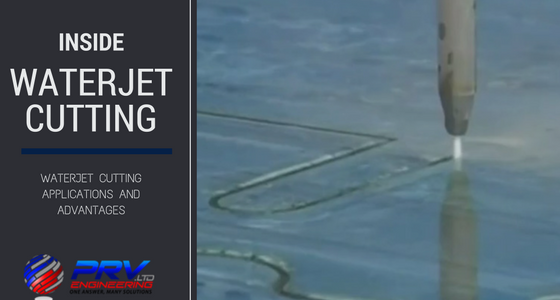History of Waterjet cutting
Waterjet cutting is often used during the fabrication process of machine parts. A waterjet cutter, also known as a waterjet, is an industrial tool capable of cutting a wide variety of materials using a very high-pressure jet or stream of water. A mixture of water and an abrasive substance is also used in many applications.
Early waterjet machines could only cut softer materials as they had low pressure and could not handle harder materials and metals. They added an abrasive to the waterjet cutting nozzle in an attempt to cut harder material which was a technique first used in the 1930’s. This was a first step in the right direction.
Early versions of the nozzle were not commercially viable though but with further development of the nozzle, things changed. The availability of a reliable pump led to a more effective waterjet that could now cut through a bigger variety of materials. The ability to cut harder materials like hardened tool steel, titanium, stone and glass truly came about in the 1970’s. The advent of the first ultra-high pressure pump resulted in faster cutting with greater precision.
An Inside look into a Waterjet cutter
PRV Engineering use the Idroline S1730 hydro-abrasive waterjet cutting system at their Pontypool based premises. It is just one of a vast array of services offered using state of the art CNC Multi Axis / Multi Discipline machining centres.
The basic components of a waterjet cutter include the following:
- High pressure pump – generates flow of pressurized water
- Articulated cutting head – computer controlled 5-axis cutting head allows for angled cuts
- Abrasive waterjet nozzle – The ability to cut materials is obtained by pressurising water to extremely high levels and then feeding that water stream through a small orifice. From there it passes through a section where a measured amount of abrasive is added. This mixture results in a coherent stream of abrasive particles traveling at a very high speed.
- X-Y Motion system – accurately moves the nozzle to create the desired cutting path
- Digital CNC communication with remote push-button panel
- Electronic hopper for abrasive automatic monitoring with sensors for cutting parameters and automatic control
- PC Controller – advanced motion controllers are PC based and allows for even inexperienced operators to use effectively
Waterjet Cutting works on almost any material
There are a whole range of materials that can be cut using this method with tempered glass being the exception. Otherwise, almost anything else can be cut. You also have to factor in the thickness of a material when considering how practical and cost effective a project will be. For instance, you can cut through 60cm of foam or rubber much more quickly than 60cm of concrete. If cutting metals, the thicker the material the longer it will take to cut.
Here is a list of composites, alloys and metals that can be cut:
- Carbon fiber-reinforced plastics – used in automotive and aerospace
- Glass-reinforced plastics – greatly beneficial for clean cutting without the hazardous dust and fumes
- Other fiber-reinforced material like Kevlar can also be cut quickly and easily
- Carbon steel – lack of heat during cutting means steel treatment remains unaffected
- Stainless Steel – heat zones from normal cutting weakens the part but with waterjet cutting, any stainless steel can be cut without any risk of failure. Waterjet cutting is a preferred method in the aerospace industry or food processing and handling equipment.
- Hardened Tool steel
- Alloys like aluminum, titanium, copper, brass, stone, ceramic, concrete, rubber and glass
One of the many advantages of waterjet cutting is that it’s done without any heat or distortion. It is the preferred method when the materials being cut are sensitive to the high temperatures generated by other methods.
Our top of the range equipment allows us to cut and machine all materials from wood, plastic and the very basic mild steels to the more exotics like, Monnel, Inconnel Hastalloy and Titanium. Get in touch with us and let’s discuss your project requirements.



Recent Comments